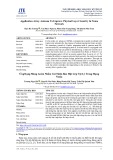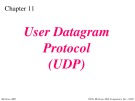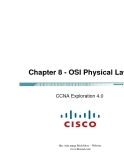
Network Layer in Communication
-
In this study, we propose a NOMA communication model combined with linear array antennas for the purpose of enhancing physical layer security. We introduce a model of 4 nodes: transmitter node S, receiver node D1, receiver node D2, eavesdropping node E.
 10p
10p  viling
viling
 11-10-2024
11-10-2024
 1
1
 1
1
 Download
Download
-
Mobile communication has received a lot of attention in the last decade. The interest in mobile communication on the Internet means that the IP protocol, originally designed for stationary devices, must be enhanced to allow the use of mobile computers, computers that move from one network to another.
 26p
26p  tangtuy09
tangtuy09
 26-04-2016
26-04-2016
 48
48
 4
4
 Download
Download
-
When you finish this chapter, you should: Be able to explain process-to-process communication, know the format of a UDP user datagram, be able to calculate a UDP checksum, understand the operation of UDP, know when it is appropriate to use UDP, understand the modules in a UDP package.
 30p
30p  tangtuy09
tangtuy09
 26-04-2016
26-04-2016
 46
46
 3
3
 Download
Download
-
Describe the structure of a network, including the devices and media that are necessary for successful communications; explain the function of protocols in network communications; explain the advantages of using a layered model to describe network functionality;... Inviting you to refer.
 102p
102p  youcanletgo_01
youcanletgo_01
 04-01-2016
04-01-2016
 68
68
 5
5
 Download
Download
-
This chapter explain the role of Transport Layer protocols and services in supporting communications across data networks, analyze the application and operation of TCP mechanisms that support reliability, analyze the application and operation of TCP mechanisms that support reassembly and manage data loss, analyze the operation of UDP to support communicate between two processes on end devices.
 74p
74p  youcanletgo_01
youcanletgo_01
 04-01-2016
04-01-2016
 54
54
 6
6
 Download
Download
-
After completing this chapter, students will be able to: Explain the role of Physical layer protocols and services in supporting communication across data networks, describe the role of signals used to represent bits as a frame as the frame is transported across the local media, describe the purpose of Physical layer signaling and encoding as they are used in networks.
 87p
87p  youcanletgo_01
youcanletgo_01
 04-01-2016
04-01-2016
 70
70
 6
6
 Download
Download
-
In chapter 4, students will be able to: Explain how physical layer protocols and services support communications across data networks, build a simple network using the appropriate, explain the role of the data link layer in supporting communications across data networks, compare media access control techniques and logical topologies used in networks.
 66p
66p  youcanletgo_01
youcanletgo_01
 29-12-2015
29-12-2015
 69
69
 4
4
 Download
Download
-
After studying this chapter students will be able to: Explain how network layer protocols and services support communications across data networks, explain how routers enable end-to-end connectivity in a small to medium-sized business network, determine the appropriate device to route traffic in a small to medium-sized business network, Configure a router with basic configurations.
 54p
54p  youcanletgo_01
youcanletgo_01
 29-12-2015
29-12-2015
 64
64
 4
4
 Download
Download
-
This chapter include objectives: Describe the purpose of the transport layer in managing the transportation of data in end-to-end communication; describe characteristics of the TCP and UDP protocols, including port numbers and their uses; explain how TCP session establishment and termination processes facilitate reliable communication;...
 31p
31p  youcanletgo_01
youcanletgo_01
 29-12-2015
29-12-2015
 41
41
 2
2
 Download
Download
-
Communication Architecture Strategy for connecting host computers and other communicating equipment. Defines necessary elements for data communication between devices. A communication architecture, therefore, defines a standard for the communicating hosts. A programmer formats data in a manner defined by the communication architecture and passes it on to the communication software. Separating communication functions adds flexibility, for example, we do not need to modify the entire host software to include more communication devices....
 18p
18p  doanhung_dtvtk10
doanhung_dtvtk10
 19-03-2013
19-03-2013
 67
67
 5
5
 Download
Download
-
This diagram illustrates the Physical layer (Layer 1) of the OSI model. The Physical layer is responsible for the ultimate transmission of data over network communications media. It operates with data in the form of bits that are sent from the Physical layer of the sending (source) device and received at the Physical layer of the destination device. Ethernet cabling, Token Ring network technology and SCSI all function at the Physical layer of the OSI model. Hubs and other repeaters are standard network devices that function at the Physical layer.
 54p
54p  thanhtq00103
thanhtq00103
 08-06-2011
08-06-2011
 115
115
 20
20
 Download
Download
-
Explain the role of Physical layer protocols and services in supporting communication across data networks.
 50p
50p  asvenus
asvenus
 24-05-2011
24-05-2011
 106
106
 8
8
 Download
Download
-
Network Troubleshooting. Objectives: In this chapter, you will learn to: Establish and document a network baseline. Describe the various troubleshooting methodologies and troubleshooting tools. Describe the common issues that occur during WAN implementation. Identify and troubleshoot common enterprise network implementation issues using a layered model approach.
 55p
55p  thanhtung_hk
thanhtung_hk
 05-11-2010
05-11-2010
 134
134
 22
22
 Download
Download
-
Physical Layer. In this chapter, you will learn to: Explain the role of Physical layer protocols and services in supporting communication across data networks. Describe the purpose of Physical layer signaling and encoding as they are used in networks. Describe the role of signals used to represent bits as a frame is transported across the local media. Identify the basic characteristics of copper, fiber, and wireless network media.
 42p
42p  thanhtung_hk
thanhtung_hk
 03-11-2010
03-11-2010
 134
134
 24
24
 Download
Download
-
OSI Transport Layer. In this chapter, we examine the role of the Transport layer. The Transport layer also encompasses these functions: Enables multiple applications to communicate over the network at the same time on a single device. Ensures that, if required, all the data is received reliably and in order by the correct application. Employs error handling mechanisms. Learning Objectives–Upon completion of this chapter, you will be able to: Explain the need for the Transport layer.
 47p
47p  thanhtung_hk
thanhtung_hk
 03-11-2010
03-11-2010
 123
123
 28
28
 Download
Download
-
Application Layer Functionality and Protocols. In this chapter, you will learn to: Describe how the functions of the three upper OSI model layers provide network services to end user applications. Describe how the TCP/IP Application Layer protocols provide the services specified by the upper layers of the OSI model. Define how people use the Application Layer to communicate across the information network. Describe the function of well-known TCP/IP applications, such as the World Wide Web and email, and their related services (HTTP, DNS, SMB, DHCP, SMTP/POP, and Telnet)....
 51p
51p  thanhtung_hk
thanhtung_hk
 03-11-2010
03-11-2010
 121
121
 28
28
 Download
Download
-
SYSTEM ANALYSIS FUNDAMENTALS FUNDAMENTALS OF SYSTEM ANALYSIS Third generation systems focus on providing a universal platform to afford multifarious communications options at all levels, i.e. the radio as well as the core network sides. This implies the application of optimum techniques in multiple access and interworking protocols for the physical and upper layers, respectively.
 28p
28p  doroxon
doroxon
 12-08-2010
12-08-2010
 105
105
 12
12
 Download
Download
-
Explain the role of Physical layer protocols and services in supporting communication across data networks. – Describe the role of signals used to represent bits as a frame as the frame is transported across the local media Describe the purpose of Physical layer signaling and encoding as they are used in networks Identify the basic characteristics of copper, fiber and wireless network media Describe common uses of copper, fiber and wireless network media
 54p
54p  thangvu89
thangvu89
 15-04-2010
15-04-2010
 190
190
 36
36
 Download
Download
-
Explain the role of Transport Layer protocols and services in supporting communications across data networks Analyze the application and operation of TCP mechanisms that support reliability Analyze the application and operation of TCP mechanisms that support reassembly and manage data loss. Analyze the operation of UDP to support communicate between two processes on end devices
 46p
46p  thangvu89
thangvu89
 15-04-2010
15-04-2010
 212
212
 36
36
 Download
Download
-
Describe the structure of a network, including the devices and media that are necessary for successful communications. Explain the function of protocols in network communications. Explain the advantages of using a layered model to describe network functionality. Describe the role of each layer in two recognized network models: The TCP/IP model and the OSI model. Describe the importance of addressing and naming schemes in network communications.
 54p
54p  thangvu89
thangvu89
 15-04-2010
15-04-2010
 178
178
 34
34
 Download
Download
CHỦ ĐỀ BẠN MUỐN TÌM
































